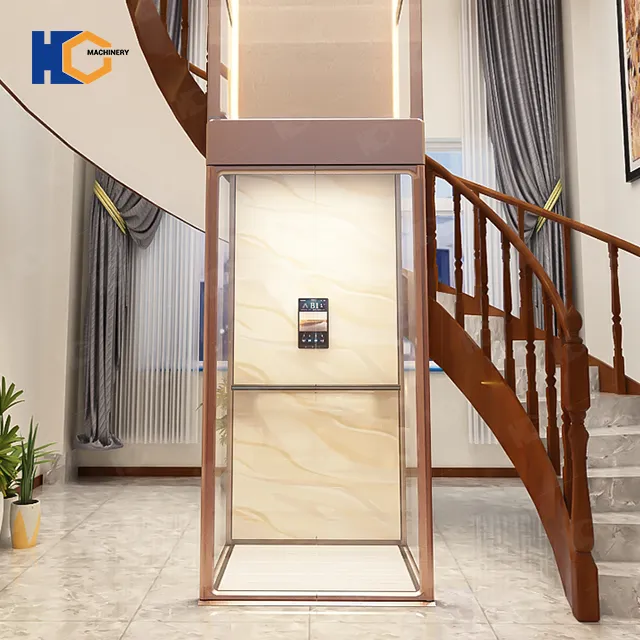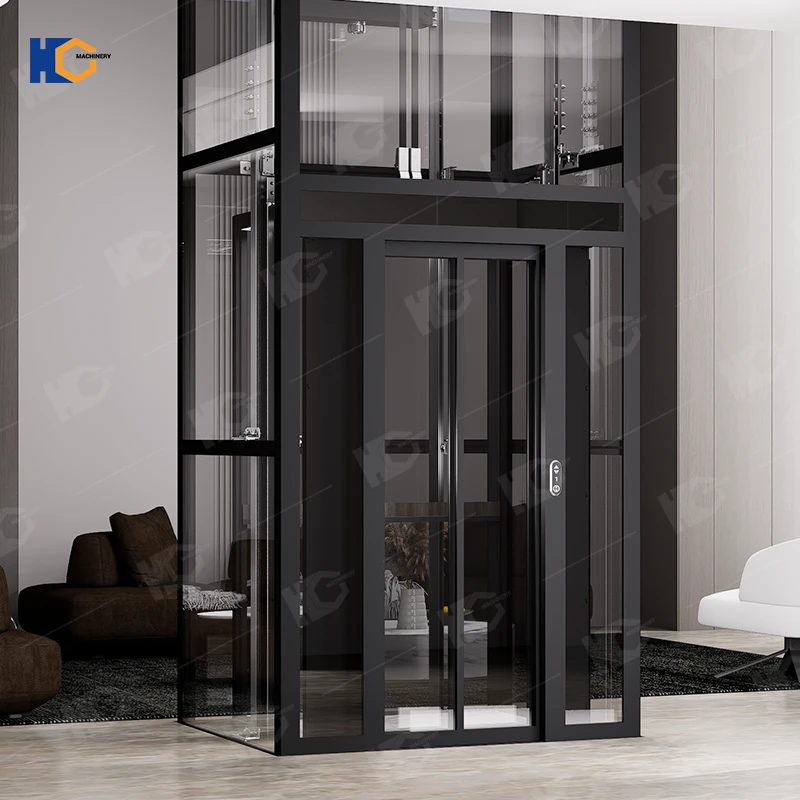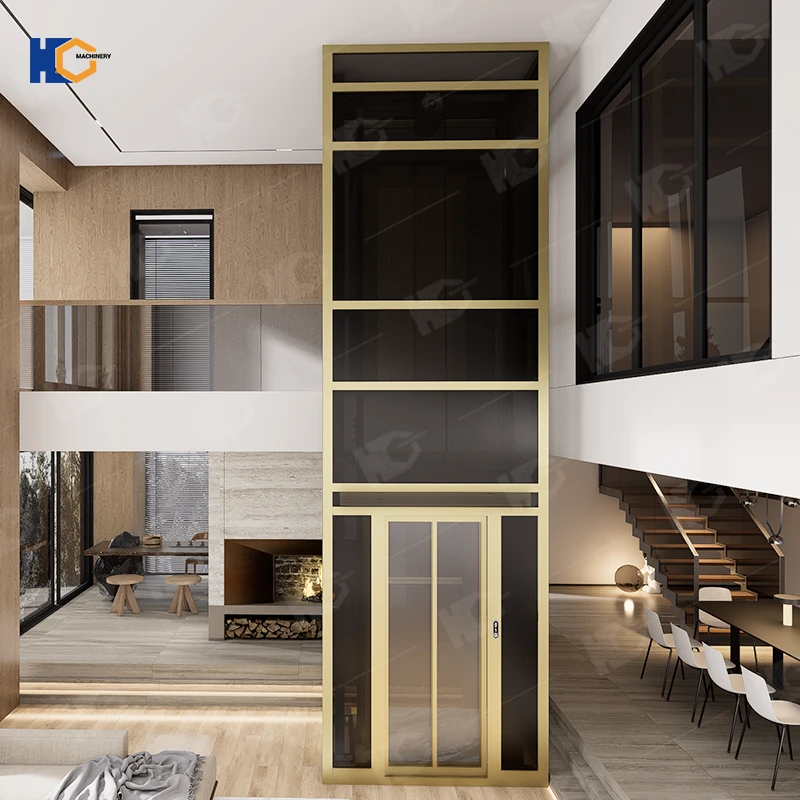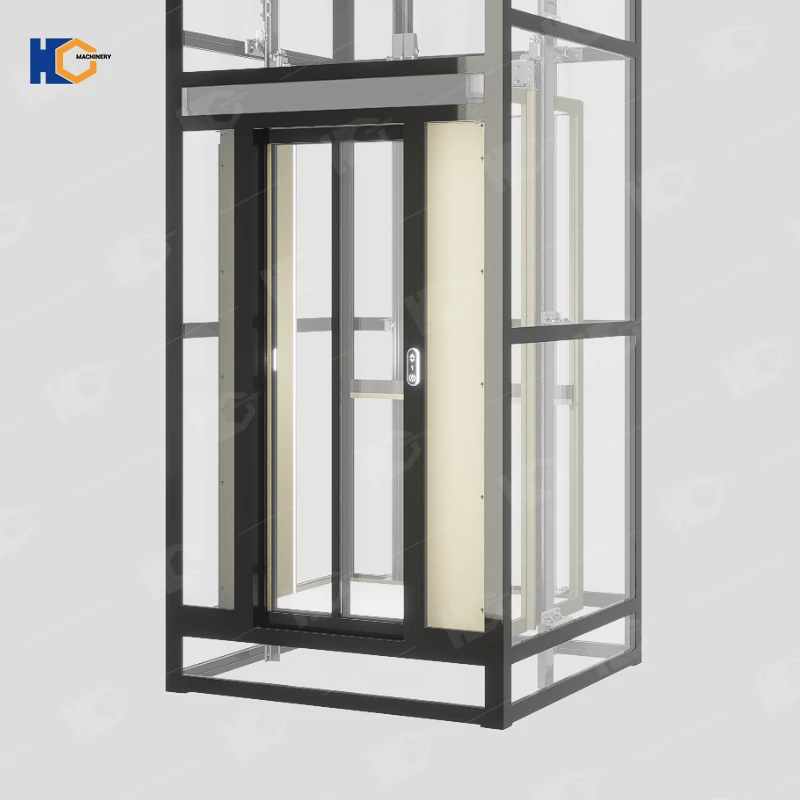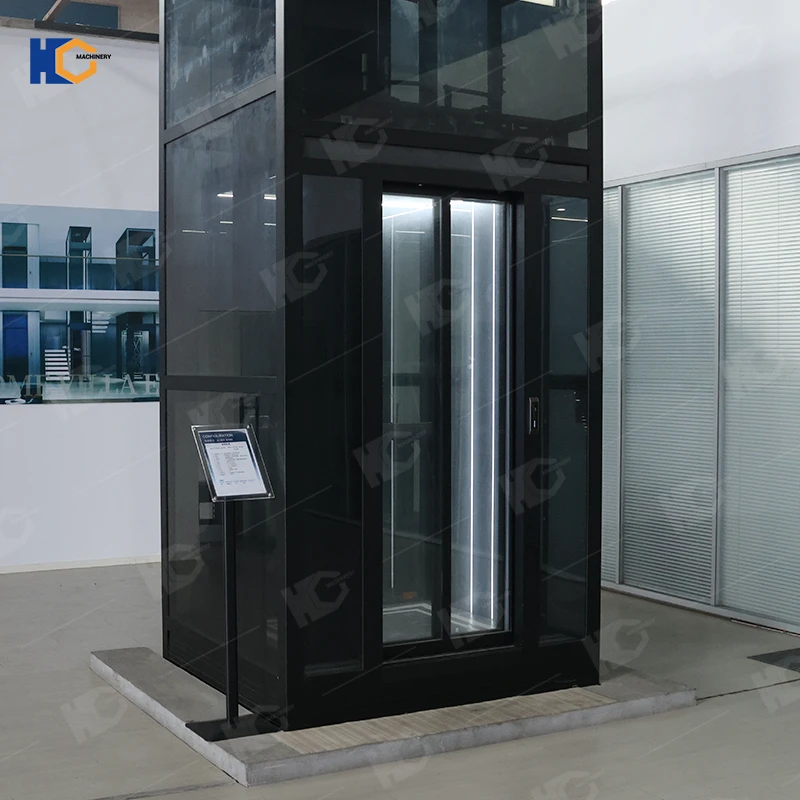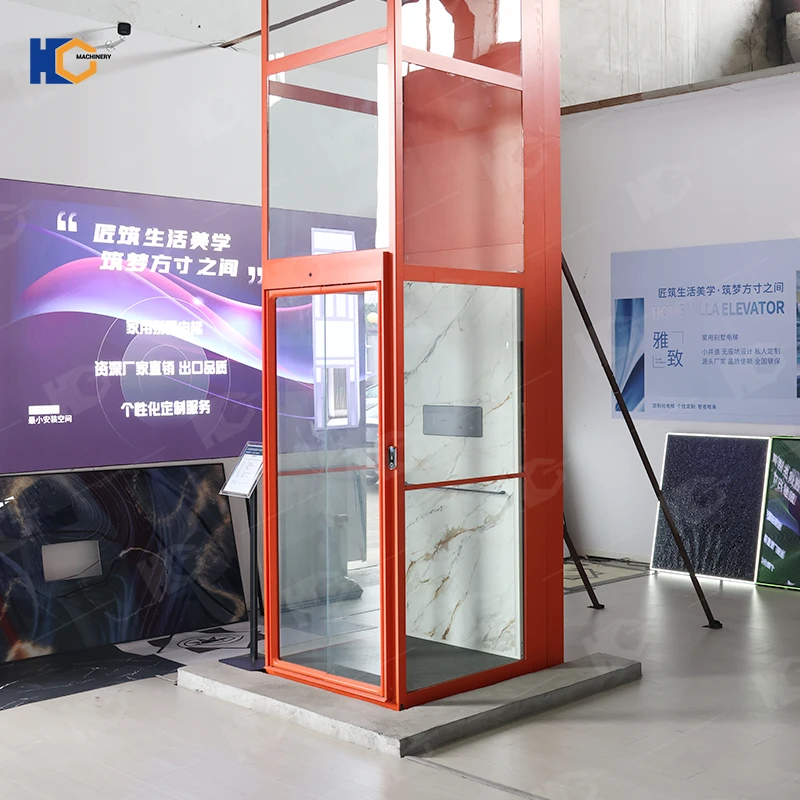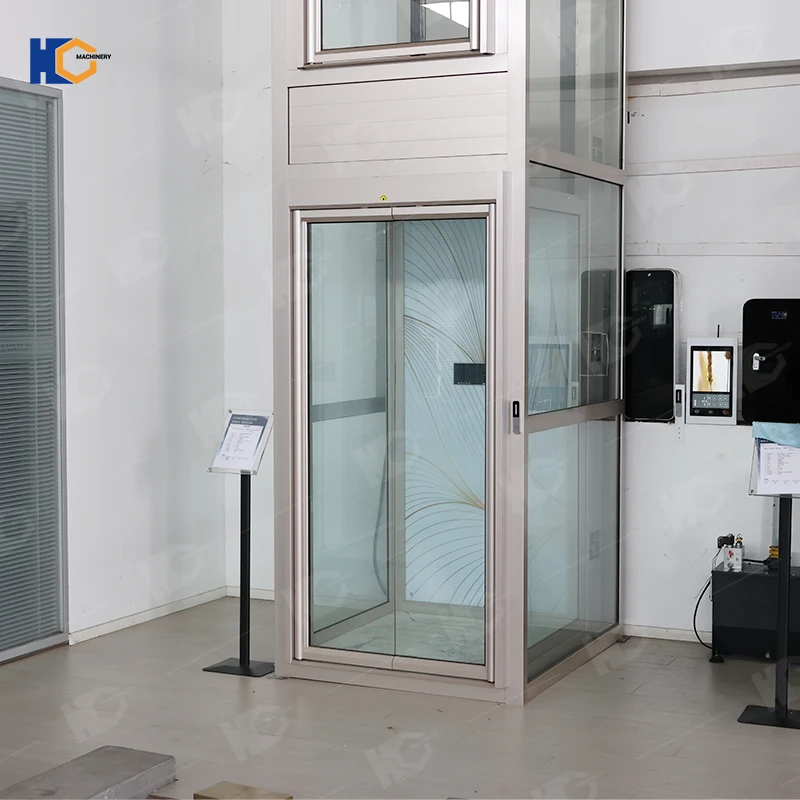![]() Small shaftless home elevator 2, 3, 4, 5 floors.pdf
Small shaftless home elevator 2, 3, 4, 5 floors.pdf
What is the shaftless home elevator?
Small shaftless home elevator is an elevator installed in a private residence for use by a single family member only. It can also be installed in a building that is not used by a single family as a tool for a single family to enter their residence, but it is not accessible and usable by the public or other residents in the building. Small shaftless home elevator is usually used for 2, 3, 4, 5 floors. The rated speed of a home elevator does not exceed 0.4m/s. For a home elevator without a car door, the rated speed does not exceed 0.3m/s, the car travel does not exceed 12m, and the rated load is not more than 400KG. The design of a home elevator focuses on aesthetics and comfort to adapt to the family's decoration style and life needs. It is usually smaller in size and slower in speed to provide passengers with a more comfortable riding experience.
589253.webp)
I’m thrilled to share my brand-new residential elevator, shown here in a bold red finish. Its sleek, minimalist frame fits seamlessly into my living room, becoming both a functional and decorative centerpiece. With its transparent glass walls and modern control panel, I can travel between floors while enjoying an open, stylish design. Installing it was straightforward, and the end result makes my home feel more spacious and convenient.
Here are typical specifications for a small shaftless home elevator for 2, 3, 4, or 5 floors:
Capacity: Usually ranges between 250 to 400 kg.
Platform Size: Varies between 800mm x 1200mm to 1000mm x 1500mm.
Speed: Average of 0.15 m/s to 0.3 m/s.
Height:
2 floors: Approx. 3.5 to 4.5 meters.
3 floors: Approx. 6 to 7 meters.
4 floors: Approx. 8 to 9 meters.
5 floors: Approx. 10 to 12 meters.
Power Supply: Typically 220V/50Hz or 380V/50Hz.
Drive Type: Hydraulic or screw drive systems.
Customization is often available based on user needs and preferences.
Key Considerations by Number of Floors
1 Two-Floor Shaftless Elevators
Cost: Typically the most affordable, ranging from USD $15,000 to $35,000, including installation.
Installation Time: Usually 1–2 weeks.
Ideal Use: Perfect for those who need basic access between ground and first floor, especially if mobility issues are a concern.
2 3-Floor Shaftless Elevators
Space Requirements: Slightly larger opening in floors; might require more robust guide rails or reinforcements.
Cost and Complexity: Typically adds around 20–30% more cost than a 2-floor model due to additional stops and safety features.
Use Case: Multi-level homes where basement access is required, or a second-story attic is frequently utilized.
3 Four-Floor Shaftless Elevators
Design Enhancements: By this point, you need to ensure that the rails, motors, and support structure are sufficiently strong.
Building Codes: More rigorous adherence to local rules—some municipalities may classify 4-floor elevators differently, requiring additional permits or inspections.
Estimated Cost: Around $30,000–$45,000, but can vary greatly.
4 Five-Floor Shaftless Elevators
Engineering Complexity: Supporting five distinct stops often necessitates a more robust and carefully planned system.
Customization: Typically, manufacturers customize these solutions to ensure safety and structural integrity.
Typical Budget: $40,000–$60,000 or more, depending on additional safety devices, finish options, and capacity requirements.
Small shaftless home elevator feature
Small design: Small shaftless home elevators usually adopt a compact design, occupy a small area, and are suitable for installation in places with limited space such as family homes of 2, 3, 4, 5 floors.
Shaftless structure: The shaftless design can reduce the changes to the building structure, and the installation is convenient and quick, while also reducing the construction cost.
Safety performance: Small shaftless home elevators are usually equipped with multiple safety protection devices, such as emergency braking systems, anti-fall devices, etc., to ensure the safety of passengers.
Energy saving and environmental protection: Small shaftless home elevators usually use energy-saving motors and control systems, which can effectively reduce energy consumption and meet the requirements of energy saving and environmental protection.
Easy operation: Small shaftless home elevators usually use intelligent control systems, which are easy and convenient to operate and suitable for special groups such as the elderly and children.
How to maintenance shaftless home elevator?
Maintaining small shaftless home elevator is important to ensure its safe and smooth operation. Here are some tips on how to maintain small shaftless home elevator:
Regular Inspections: Conduct regular inspections of the elevator components, such as the motor, cables, safety devices, and control panel. Look for any signs of wear and tear, loose connections, or unusual noises.
Lubrication: Keep the moving parts of the elevator well-lubricated to prevent friction and ensure smooth operation. Follow the manufacturer's guidelines for the type and frequency of lubrication needed.
Cleaning: Regularly clean the elevator cab and components to remove dust, dirt, and debris that can affect the elevator's performance. Pay special attention to the door tracks and sensors.
Testing Safety Features: Test the safety features of the elevator, such as emergency stop buttons, door sensors, and overload protection, to ensure they are functioning properly
Schedule Professional Maintenance: It is recommended to schedule regular maintenance checks by a qualified technician to inspect and service the elevator components. They can identify any potential issues and perform necessary repairs to keep the elevator in good working condition.
Follow Manufacturer's Guidelines: Follow the manufacturer's maintenance guidelines and recommendations for your specific shaftless home elevator model. This will help ensure the elevator's longevity and safe operation.
By following these maintenance tips and guidelines, you can help prolong the lifespan of your shaftless home elevator and ensure the safety of its users.
Practical Tips and Feasibility Suggestions
Conduct a Home Assessment
Before settling on a shaftless model, consider hiring a structural engineer or a contractor familiar with elevator installations to evaluate your home. They will inspect the potential installation site, assess floor joists, and ensure that the design meets local codes.
Tip: Request multiple quotes from reputable elevator companies. Prices can vary widely based on finishes, safety features, and brand reputation.
Prioritize Safety and Code Compliance
Local building codes differ significantly by region. In many jurisdictions, small shaftless elevators must still follow the same safety regulations as traditional residential elevators. Common safety features include:
Interlocks: Doors won’t open unless the cab is at the correct floor.
Sensors: Infrared or pressure sensors to prevent the elevator from moving if the doorway is obstructed.
Backup Systems: Battery lowering or manual crank for power outages.
Statistics:
The Consumer Product Safety Commission (CPSC) recorded an average of 2,700 elevator-related injuries (both commercial and residential) annually in the United States. Ensuring proper installation and maintenance drastically reduces the risk.
Weight Capacity and Usability
Small shaftless home elevators often have capacities ranging from 350 to 600 pounds. While this may be fine for a person using a wheelchair or carrying groceries, it may not be adequate for heavier loads like large furniture or medical equipment.
Recommendation: If you foresee needing to move heavy furniture between floors, discuss higher capacity or alternative models with your installer.
Design and Aesthetics
Many shaftless models offer customizable finishes, from sleek glass enclosures to wood-paneled cabins. This can help the elevator blend seamlessly into your home’s interior design. Some even add design flair with LED lighting, modern railings, and minimalist frames.
Case Study: A homeowner in New York added a glass-enclosed shaftless elevator to their contemporary townhouse. The transparent design allowed natural light to filter through, maintaining an open, modern feel while enabling quick travel between four floors.
Operating Costs and Maintenance
While shaftless elevators often have lower initial construction costs compared to full-shaft systems, it’s essential to factor in ongoing expenses:
Maintenance: Annual or semiannual check-ups typically cost $200–$500, depending on the model and local service rates.
Energy Consumption: Most units are relatively energy-efficient, comparable to operating a standard home appliance, especially if using newer motor drives.
Repairs: Keep some funds aside for unplanned maintenance, like motor or control panel replacements.
What is the shaftless home elevator price?
The price of a shaftless home elevator can vary depending on the floor, size, features, and configuration. On average, small shaftless home elevator 2, 3, 4, 5 floors can cost anywhere from $4,000 to $20,000 or more. It is recommended to get details quote from elevator supplier.
Real-World Examples and Data
Suburban Home, 2-Floor Shaftless Elevator
Location: Austin, Texas
Cost: $25,000 total, including installation
Outcome: Installation finished in 10 days. The elderly homeowners reported a 60% reduction in stair-related strain and a greater sense of independence.
City Townhouse, 4-Floor Shaftless Elevator
Location: Chicago, Illinois
Cost: $40,000 total, with some structural modifications
Outcome: Elevator was used daily for groceries, laundry, and rooftop deck access. Home resale value increased slightly, though not every buyer valued the added feature.
Commercial-Style Loft, 5-Floor Shaftless Elevator
Location: San Francisco, California
Cost: $60,000, primarily because of custom glass panels and advanced safety sensors
Outcome: Provided essential ADA-compliant access. Property management reported a high level of tenant satisfaction, particularly for individuals with mobility challenges.
Making Your Decision
Evaluate Your Budget and Long-Term Plans
Small shaftless home elevators are an investment. Decide whether you plan to remain in your home long-term or if you might sell in the near future. If you plan to sell, consider whether a potential buyer would find value in having an elevator. According to the National Association of Realtors, specialized home improvements recoup anywhere from 50% to 70% of their costs, depending on market conditions.
Consult Professionals Early
Working with a reputable elevator company is crucial. They can guide you on:
Structural requirements
Compliance with local building codes
Appropriate safety features
Customization options (finishes, door styles, lighting)
Tip: Read online reviews, ask for referrals, and verify that the installer is licensed and insured.
Planning for Installation Logistics
When scheduling installation, consider factors such as:
Living Arrangements: You might need to vacate certain areas or endure noise and dust.
Timeline: Most 2-floor installations take 1–2 weeks, but with 3–5 floors, add more time for planning and potential structural work.
Permits: Building permits, inspections, and potential HOA approvals may add extra steps to the process.
Sustainability and Energy Use
Modern shaftless elevators often come with energy-efficient motors that minimize power usage. Some models have standby modes that reduce consumption when not in use. If eco-friendliness is a concern, inquire about:
Regenerative drives
LED lighting
Low-voltage controls
Conclusion
A small shaftless home elevator can provide significant benefits for homeowners looking to simplify multi-level living. Whether you need better mobility, want to future-proof your home for aging in place, or simply desire the convenience of traveling between 2, 3, 4, or 5 floors, shaftless elevators offer a space-saving and often cost-effective solution.
Before committing, ensure you thoroughly assess your home’s structural feasibility, local building codes, and your own long-term goals. Consult with experts to pick the right size, design, and safety features to match your needs. Although adding an elevator to a home is a significant investment, the comfort, accessibility, and potential increase in home value can make it well worth the effort.
By keeping these practical tips, real-world examples, and up-to-date data in mind, you will be better equipped to decide whether a small shaftless home elevator is right for you. With careful planning and professional guidance, you can select a system that seamlessly integrates into your home, delivering the convenience of multi-level access without the bulk and complexity of a traditional shafted elevator.
JNHC LIFT is a highly reputable shaftless home elevator manufacturer based in China, known for its strong industry presence and exceptional quality. We specialize in designing and producing a wide range of elevator solutions, including home elevators, commercial lifts, and custom installations. Our state-of-the-art manufacturing facilities and experienced engineering team ensure that every elevator meets the highest standards of safety, performance, and aesthetics. If you are interested in obtaining a detailed quotation, we invite you to contact us directly. Our dedicated team will work closely with you to understand your specific requirements and provide a comprehensive quote that reflects the most competitive prices available. At JNHC LIFT, we are committed to delivering outstanding value and service, making us a trusted partner for your elevator needs. Reach out to us today to discover how we can help you achieve your vision with the best possible pricing.
